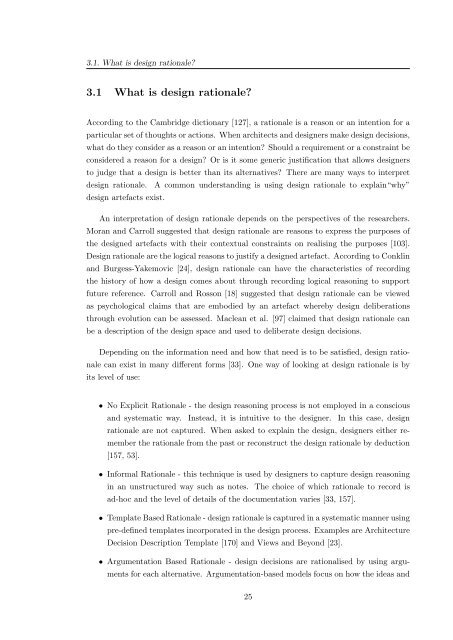A Rationale-based Model for Architecture Design Reasoning
A Rationale-based Model for Architecture Design Reasoning
A Rationale-based Model for Architecture Design Reasoning
You also want an ePaper? Increase the reach of your titles
YUMPU automatically turns print PDFs into web optimized ePapers that Google loves.
3.1. What is design rationale?<br />
3.1 What is design rationale?<br />
According to the Cambridge dictionary [127], a rationale is a reason or an intention <strong>for</strong> a<br />
particular set of thoughts or actions. When architects and designers make design decisions,<br />
what do they consider as a reason or an intention? Should a requirement or a constraint be<br />
considered a reason <strong>for</strong> a design? Or is it some generic justification that allows designers<br />
to judge that a design is better than its alternatives? There are many ways to interpret<br />
design rationale. A common understanding is using design rationale to explain“why”<br />
design artefacts exist.<br />
An interpretation of design rationale depends on the perspectives of the researchers.<br />
Moran and Carroll suggested that design rationale are reasons to express the purposes of<br />
the designed artefacts with their contextual constraints on realising the purposes [103].<br />
<strong>Design</strong> rationale are the logical reasons to justify a designed artefact. According to Conklin<br />
and Burgess-Yakemovic [24], design rationale can have the characteristics of recording<br />
the history of how a design comes about through recording logical reasoning to support<br />
future reference. Carroll and Rosson [18] suggested that design rationale can be viewed<br />
as psychological claims that are embodied by an artefact whereby design deliberations<br />
through evolution can be assessed. Maclean et al. [97] claimed that design rationale can<br />
be a description of the design space and used to deliberate design decisions.<br />
Depending on the in<strong>for</strong>mation need and how that need is to be satisfied, design rationale<br />
can exist in many different <strong>for</strong>ms [33]. One way of looking at design rationale is by<br />
its level of use:<br />
• No Explicit <strong>Rationale</strong> - the design reasoning process is not employed in a conscious<br />
and systematic way. Instead, it is intuitive to the designer. In this case, design<br />
rationale are not captured. When asked to explain the design, designers either remember<br />
the rationale from the past or reconstruct the design rationale by deduction<br />
[157, 53].<br />
• In<strong>for</strong>mal <strong>Rationale</strong> - this technique is used by designers to capture design reasoning<br />
in an unstructured way such as notes. The choice of which rationale to record is<br />
ad-hoc and the level of details of the documentation varies [33, 157].<br />
• Template Based <strong>Rationale</strong> - design rationale is captured in a systematic manner using<br />
pre-defined templates incorporated in the design process. Examples are <strong>Architecture</strong><br />
Decision Description Template [170] and Views and Beyond [23].<br />
• Argumentation Based <strong>Rationale</strong> - design decisions are rationalised by using arguments<br />
<strong>for</strong> each alternative. Argumentation-<strong>based</strong> models focus on how the ideas and<br />
25
















